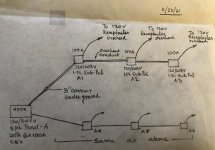Samardas
Member
- Location
- Los Angeles, CA, United States
- Occupation
- Electrical Engineer
Hi,
A 400A, 120/208V, 3 Phase Panel will feed 3 x 120/208V, 1 Phase Sub-panels (panel) along the same line with a furthest distance of the Sub-panel at about 230'. Since each panel is 100A, 120-208V, 1 Phase, the proposal is to run 6 phase conductors with 1 Neutral conductor to the first panel and then continue to the third panel ending with 2 conductors and the same common neutral. The question - is it required to run a neutral for each panel from the 400A Panel, making the total neutral to the first panel to be 3? In other words, is it necessary to run 9 conductors up to the first Sub-panel or 7 is good enough using the same neutral for all the panels? Does the size of the neutral change in the 7-conductor configuration, if it is permitted? Your help will be highly appreciated. Thanks
A 400A, 120/208V, 3 Phase Panel will feed 3 x 120/208V, 1 Phase Sub-panels (panel) along the same line with a furthest distance of the Sub-panel at about 230'. Since each panel is 100A, 120-208V, 1 Phase, the proposal is to run 6 phase conductors with 1 Neutral conductor to the first panel and then continue to the third panel ending with 2 conductors and the same common neutral. The question - is it required to run a neutral for each panel from the 400A Panel, making the total neutral to the first panel to be 3? In other words, is it necessary to run 9 conductors up to the first Sub-panel or 7 is good enough using the same neutral for all the panels? Does the size of the neutral change in the 7-conductor configuration, if it is permitted? Your help will be highly appreciated. Thanks

